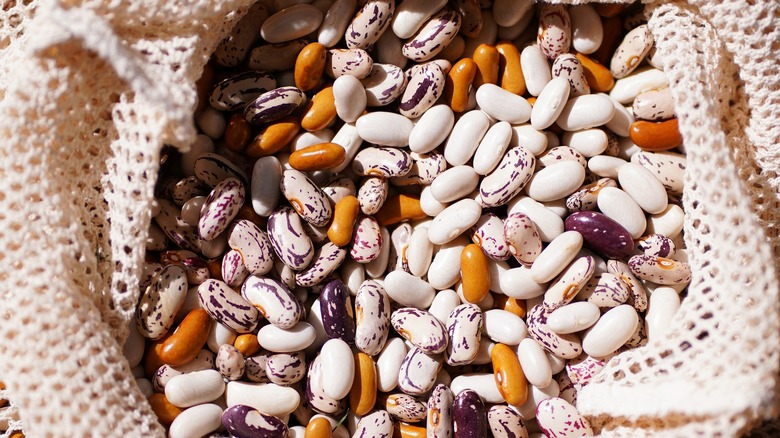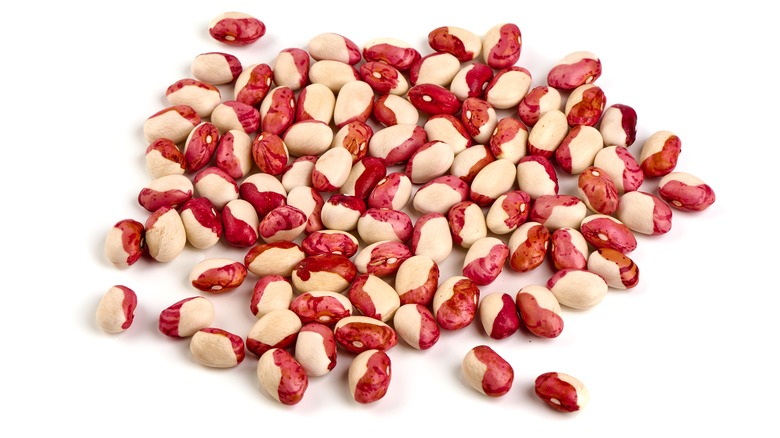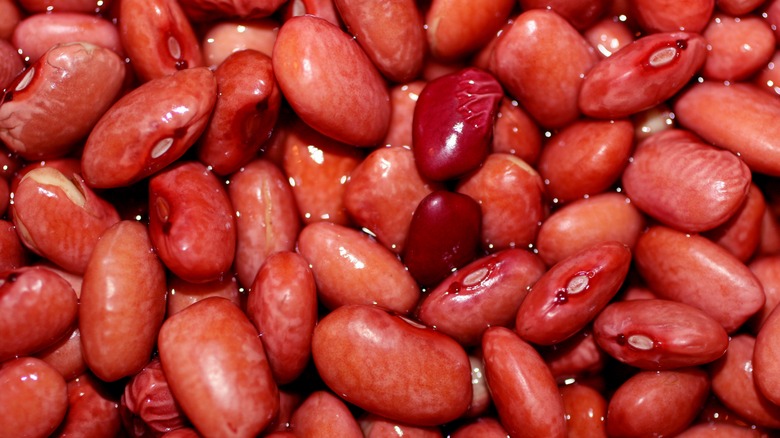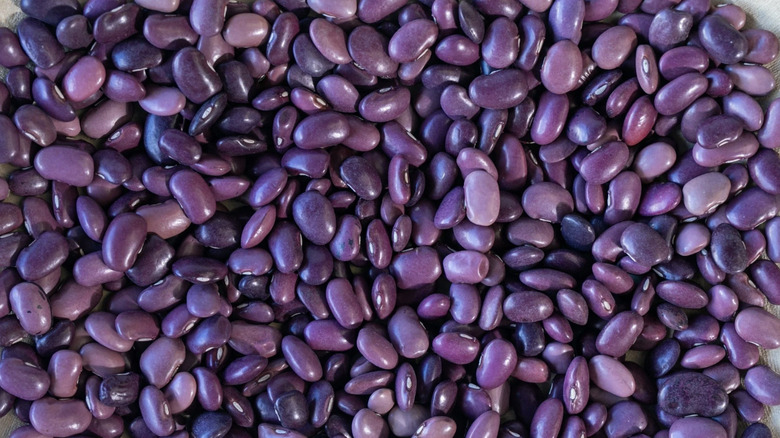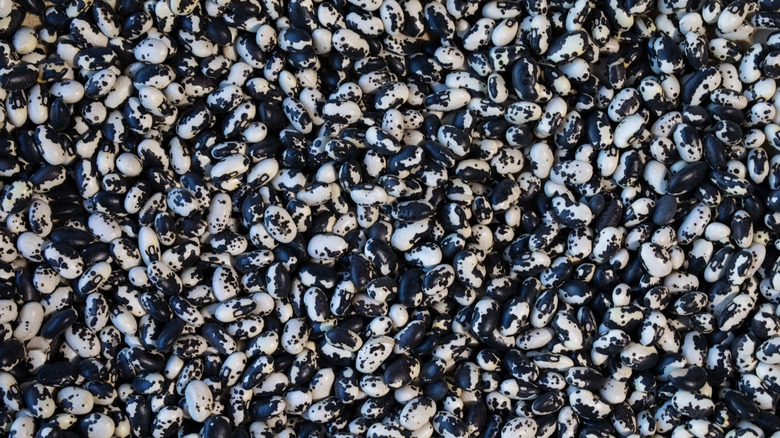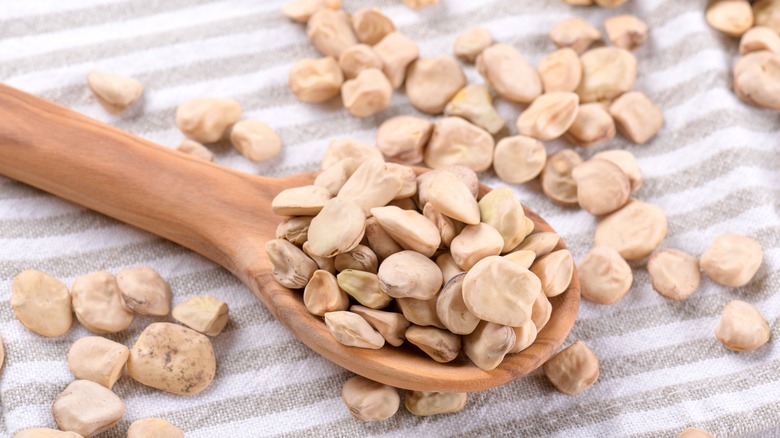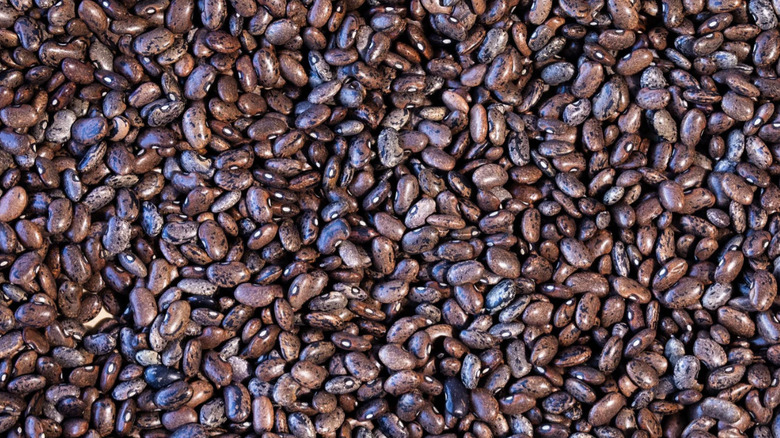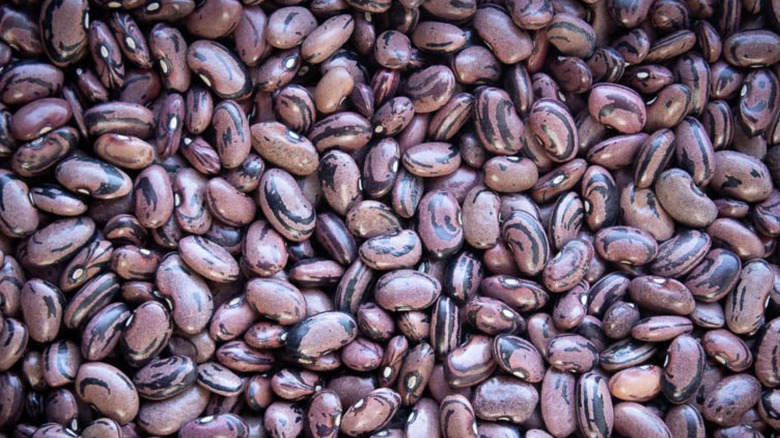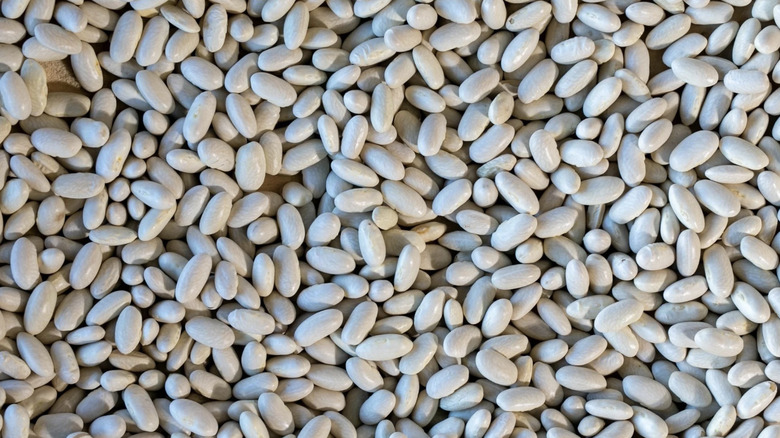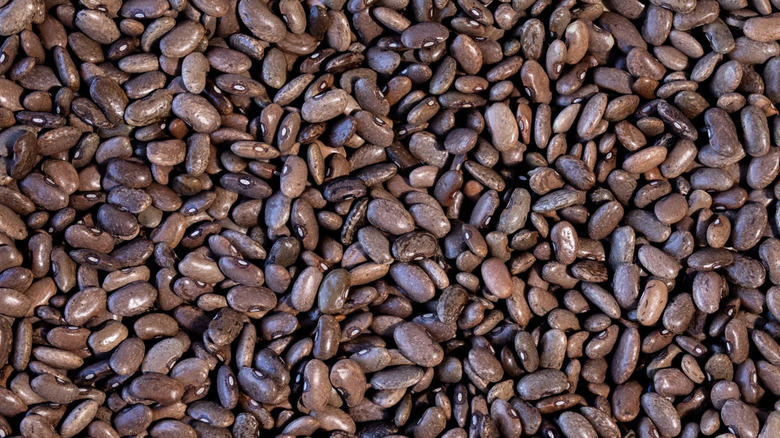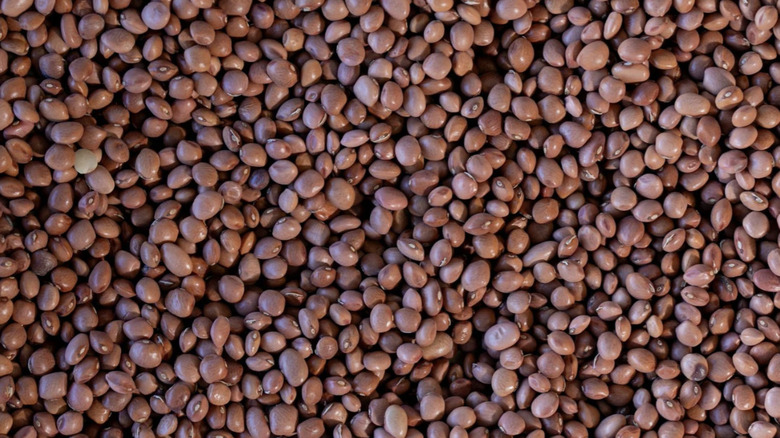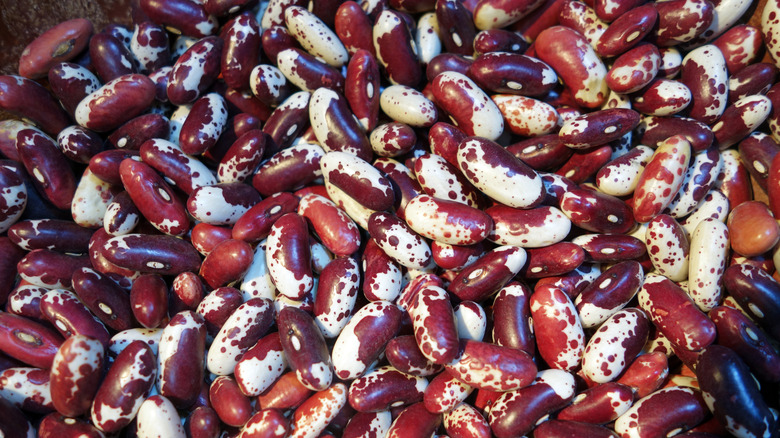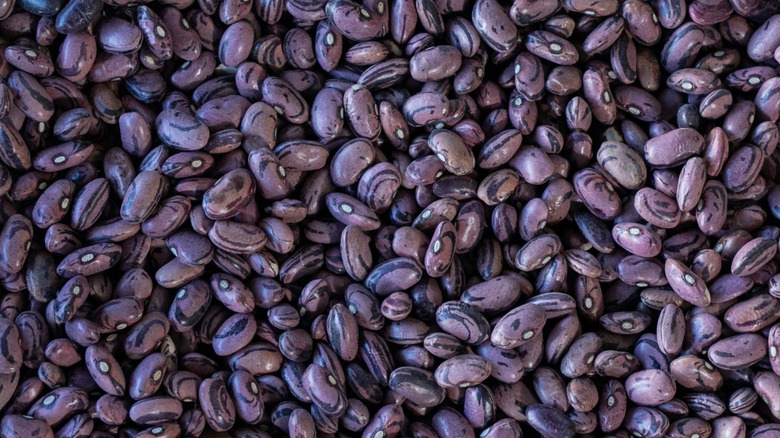12 Types Of Heirloom Beans And How To Use Them In Your Cooking
Most of us are used to cooking with the same old beans. Pintos, black beans, garbanzo beans, kidney beans — these are all common choices we've probably cooked 100 times at least. But, if you're sick of them and want a change, you might be wondering about heirloom beans and how to cook with them.
First off, perhaps you want to know more about what they are. Heirloom beans are varieties that have been passed down through generations of farmers and gardeners. Usually, they need to have existed for at least 50 years before they can be classed as heirloom. They're usually non-GMO and open-pollinated, which means they reproduce true to type from seed, unlike hybrid varieties. What's more, they come in a wide range of colors, shapes, sizes, and flavors and have historical or cultural significance in specific regions. Overall, they're less commercialized — they're often grown on small farms or in home gardens.
They can be hard to get hold of outside of small growers or specialty stores, but Rancho Gordo is probably the best-known seller of heirloom beans in the U.S. If you can get hold of heirloom varieties, you can enjoy flavors and textures you won't get from a grocery store can of beans. While there are countless varieties, here are 12 types of heirloom beans and how to use them in your cooking.
Anasazi beans
If you're looking for heirloom beans with a long history, Anasazi beans tick that box. They may date all the way back to the first century A.D. Anasazi beans are named after an ancient Native American civilization that cultivated them. However, it's worth noting that "Anasazi" was the name given to them by neighboring tribes. They're more accurately known as Puebloans.
Despite being ancient, these beans have somehow managed to keep being cultivated all these years. There are legends about them being rediscovered by archaeologists, but it's likely they've just been grown by Indigenous Americans for generations before being discovered and cultivated by white colonial settlers. They have a distinctive appearance – they're white with reddish-maroon patches and speckles. Their flavor is mild but nutty, somewhat similar to a chestnut. They're firm enough to keep their shape in recipes but have a creamy, velvety texture.
They're somewhat similar to pinto beans and kidney beans, so a great place to start when figuring out how to cook with them is to use them in recipes where you'd otherwise use these beans. For instance, you can use them as a substitute for pinto beans in refried bean recipes. Their creamy texture also makes them a great choice for hearty soups or stews, including chili. Or, you can cook and cool them, then add to green salads or grain-based salads. They're especially well-suited to Southwestern cuisine.
King City pink beans
King City pink beans are a variety of heirloom beans named after King City, California, where they were originally cultivated. If you already know what pink beans are and what they taste like, the King City variety is similar, but with its own twist. They're richly flavorful — particularly the broth after cooking. Although they're creamy inside, they could also be described as dense, they're not super soft or prone to falling apart, despite their thin skin.
But, how should you cook with them? They're excellent for use in traditional Mexican and Southwestern American cuisine. Although they look quite a lot like pinto beans, they're more similar to buckeye beans or black turtle beans. One popular way to prepare them is to simmer them with onions, garlic, and spices and serve them over greens or rice — however, you can also add them to a range of dishes.
These beans work wonderfully in chili, baked bean recipes, or classic beans and rice dishes. You can also use them in refried beans, offering a slightly different flavor profile than the more common option, pinto beans. King City pinks are great in soups and stews, where they absorb the flavors of the broth while maintaining their shape and texture.
Ayocote morado beans
Ayocote morado beans are another variety with a rich history. Beans from this family were one of the first to be cultivated in the Americas. They're widely grown over much of Central and Northern Mexico, though less common in other parts of North America. You won't mistake these plump, chunky beans for anything else, due not only to their size but their rich purple hue.
They're not just big but have a robust, meaty texture. For some, they're a great alternative to meat in dishes that often call for it, like stews or chilis. Depending on how you cook them, they can be dense and starchy or exceptionally creamy. Some people say they're versatile enough to be used in almost any recipe, but there are still some places where they shine.
They're particularly great in chilis or in a rich mole sauce, though they're robust enough to be eaten as a side without much adulteration. You can use them in all kinds of salads, but it's a good call to lean into their Mexican and Southwestern style by pairing them with ingredients like charred corn and avocado.
Vaquero beans
Vaqueros – sometimes also known as cowboy beans — are a striking heirloom variety. They're named for their distinctive black and white speckled pattern, which looks a bit like the pinto horses often ridden by cowboys. These beans are related to Anasazi beans and have a fairly similar flavor and texture.
Vaquero beans are medium-sized and hold their shape well when cooked. The texture is creamy yet dense and they taste mild and a little bit nutty, although some describe them as potato-like. They absorb flavors well, which makes them excellent for use in a wide range of recipes. When cooked, they develop a rich, meaty broth, or pot liquor, that's an inky black hue and adds depth to any dish they're used in.
Learning how to cook different types of beans is a big part of making the most of them. One popular way to prepare vaqueros is in a simple pot of beans, simmered with onions, garlic, and spices. Enjoying them this way puts them center stage. However, you can also cook them like this and then add them to other dishes. They're particularly well-suited for Southwestern and Mexican cuisine, working wonderfully in chili, burritos, and rich stews.
They're also a great pick for salads. Their firm texture means they won't fall apart when tossed with other ingredients, and their mottled appearance makes for an eye-catching dish. What's more, they blend nicely into dips and could even work as a non-standard choice for refried beans.
Cicerchia beans
Cicerchia beans have been cultivated in the Mediterranean for thousands of years and are hugely popular in Italy. They're small, angular, and almost toothlike in shape, but don't let their unusual appearance put you off. They taste somewhat similar to chickpeas but with a richer, earthier flavor. That said, although they're dried, they have a freshness to them, a little like garden peas.
They're traditionally used in rustic Italian cuisine, particularly in the Central and Southern regions of Italy. They have a firm texture that holds up well during cooking, making them suitable for a variety of dishes. Some people like to keep it simple when cooking them to let their flavors come to the forefront. You can simply cook them with aromatics like garlic and herbs, and finish them with a drizzle of good olive oil. They also blend down into a delicious silky purée.
But, you can get more creative with cicerchia beans if you want to. These beans work well in hearty stews and casseroles. They're an obvious choice for Italian favorites, such as Tuscan zuppa di cicerchie or pasta e fagioli. You can even serve them in their broth as a soup with few other ingredients.
Moro beans
These beautiful mottled beans might be gorgeous to look at, but luckily they taste great, too. Moro beans hail from Mexico and are rare, even by heirloom standards. However, you can buy them from iconic heirloom bean growers Rancho Gordo. These have a base tone that ranges from greenish to purple with darker speckles all over. When cooked, they turn a rich dark brown and develop a creamy texture with a slightly sweet, earthy flavor.
Generally, moro beans are perfect for Mexican and Southwestern cuisine, although you can absolutely look beyond that. They're somewhere between a black bean and a pinto bean in taste and texture, but with their own thing going on, too. They're velvety but still reasonably firm and hold their shape well.
They're delicious eaten straight up and the broth you're left with after cooking them is rich and delicious in its own right. They're great in soups and stews, pairing well with richly umami ingredients, like mushrooms and bacon. However, they're also nice with something fresh to contrast them, like kale or cilantro.
When cooking with moro beans, consider pairing them with ingredients that complement their earthy, slightly sweet flavor. They work well with bold spices, acidic ingredients like tomatoes or lime juice, and fresh herbs. They're good as refried beans or made into dips. Basically, they're pretty versatile.
San Franciscano beans
Despite the name, San Franciscano beans don't come from San Francisco but rather from Mexico. They're striped with purple and black hues and are closely related to Rio Zape, another type of heirloom bean on this list. Flavor-wise, they're similar to pinto beans, but they have a firmer, denser texture. They're also somewhat richer than pintos, with slight notes of coffee and chocolate that leach out into the bean broth, as well, when you cook them.
If you've ever found a recipe that calls for pintos but you've found the beans fall apart a little too much, San Francisanos are the perfect alternative. They're great in soups, chilis, stews, and even salads. However, they're so good that you may prefer to eat them plain. Simply cook them in a pot with aromatics until they're soft and serve them with a scoop of their pot liquor. You can choose to top them with extras like salsa, sour cream, cheese, and fresh cilantro. To make the most of them, you might want to try some of our expert-approved suggestions for cooking beans.
Marcella beans
Marcella beans are named after the renowned Italian cookbook author Marcella Hazan. They're similar to cannellini beans – in fact, they're technically a rare type of cannellini called Sorana beans. They can be enjoyed in the same way as pretty much any other European white beans. They stand out for their tender texture and delicate, buttery flavor and are particularly prized for their thin skins and creamy insides.
Like other beans, they're high in protein, making them a filling addition to a range of dishes. One simple way to enjoy Marcella beans is to cook them with aromatics like garlic, sage, and olive oil, creating a rustic Italian-style bean dish. They're also excellent in soups and stews, where their creamy texture adds body and they bring their own mild flavor.
Marcella beans are delicious in salads, both warm and cold. Their delicate flavor pairs well with vinaigrettes and fresh herbs, making them a great base for a bean salad or mixed in with leafy greens. You can smash them on toast with garlic, a generous drizzle of olive oil, and a squeeze of lemon to brighten it up. They're also delicious in various pasta dishes, such as pasta e fagioli.
Rebosero beans
Native to the rural Hidalgo region of Mexico, rebosero beans are small but pack a big, flavorful punch. They have a distinctive mottled pattern of pinkish-brown and beige colors. When cooked, they develop a balanced texture and a rich, earthy flavor. The bean broth is especially tasty, too. They're somewhat similar to pinto beans and moro beans.
They're not excessively creamy nor particularly firm or starchy, they're somewhere in the middle. This makes them a versatile choice for various recipes. However, they work best in Mexican and Southwestern dishes.
In traditional Mexican cooking, rebosero beans are often prepared as frijoles de la olla, or pot beans. This involves simmering them with onions, garlic, and sometimes herbs like epazote, resulting in a flavorful broth and tender beans. You can serve the cooked beans as is, or mashed and refried to create a delicious side dish or filling for tacos and burritos.
These beans excel in soups and stews. They work particularly well in dishes like charro beans, a Mexican bean dish often made with bacon, chilies, and tomatoes. You can also use rebosero beans in chili or turn them into refried beans. When refried, they have a smoother texture and richer flavor compared to standard pinto beans.
Santa Maria Pinquito beans
Santa Maria Pinquitos are small, pink-colored heirloom beans native to the Santa Maria Valley in California. Fans love them for their firm texture, nutty flavor, and ability to hold their shape well during cooking. They are an essential component of Santa Maria-style barbecue, a regional culinary tradition that originated on the coast in Central California.
Santa Maria Pinquito beans have a rich, meaty flavor that sets them apart. Their small size lets them cook relatively quickly compared to larger beans. When cooked, they still stay pretty firm, making them great for any dishes where mushiness or soft, creamy textures aren't what you want.
In traditional Santa Maria-style barbecue, these beans are often prepared as a side dish. Everyone has their own recipe, but they're usually simmered with bacon, onions, garlic, chiles, and spices. The broth also has a meaty, robust flavor, adding to the dish. However, there are many other ways to eat them. They're great in chili, where their small size and firm texture add to the dish. They can hold up to long cooking times without breaking down, making them perfect for slow-cooked recipes. Since they hold their shape well, they're also perfect in a variety of salads.
Jacob's cattle beans
Jacob's cattle beans are a type of Appaloosa bean. They're so-called because of their brown and white speckled coloring, which is said to resemble Hereford cattle. Or, if you look at their other name, it's because of their resemblance to Appaloosa horses. Their texture is often described as dense and meaty, making them a great choice for any dishes where you want a robust bean. They're rich in flavor, with fruity and nutty notes.
There are mistakes everyone makes when cooking beans and Jacob's cattle varieties aren't immune to these. However, it's easy enough to make them taste good. You can simply cook up a pot and eat them — they're that tasty — but they also work well in various other recipes. They're not unlike kidney beans, so you can sub them in recipes that call for red beans.
They're particularly good in hearty winter soups, perhaps combined with root vegetables. You can also use them in chili, bringing their flavor, texture, and striking appearance. They work well in Italian dishes like pasta e fagioli or minestrone soup. Or, you can purée them into dips or spreads or mix them into salads.
Rio Zape beans
If you're looking for flavorful heirloom beans that are great in Mexican and Southwestern dishes, Rio Zapes fit the bill. They're around the size of pinto beans and can be used in similar ways, but they've got more to them, flavor-wise. They're often described as having a complex, earthy flavor with hints of chocolate and coffee. Some tasters also note subtle undertones of fruit or wine. So, they're way more complex than any can of beans you could pick up at the grocery store.
They have a velvety, smooth texture but still manage to maintain their shape. They also produce a rich, flavorful broth that is prized in many dishes. If you're wondering how to use these beans in your cooking, you'll be pleased to know they're versatile and work well in a variety of dishes.
They're perfect for traditional Mexican dishes and cooking methods, such as pot beans or refried beans. Their rich flavor adds depth to these simple dishes. Rio Zape beans are also tasty in soups, complementing other ingredients while contributing their own flavor. We love how their chocolate and coffee notes can add complexity to chili recipes. Because they're creamy when cooked, they're excellent for dips and spreads. They can also elevate traditional baked bean recipes with their rich flavor. You can throw them in salads or stuff them into burritos or enchiladas.
